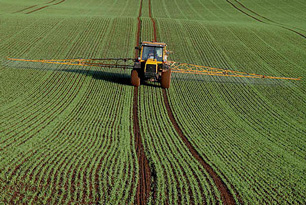Atrazine
| EPA Maximum Contaminant Level (MCL) |
0.003 mg/L |

Atrazine is an herbicide used to control grasses and broadleaf weeds around row crops such as corn, sorghum and sugarcane. Its use has been banned in the European Union since 2003, but it remains the second most pervasive agricultural herbicide in the United States after glyphosate (Roundup®).
It typically arrives in drinking water through agricultural runoff. A recent article in the New York Times reports that it “has become among the most common contaminants in American reservoirs and other sources of drinking water” and that home filtration is at times one of the only methods of avoiding atrazine:
Sometimes, the only way to avoid atrazine during summer months, when concentrations tend to rise as cropland is sprayed, is by forgoing tap water and relying on bottled water or using a home filtration system.
Health Effects of Atrazine
According to the EPA, atrazine can lead to cardiovascular and reproductive issues:
Some people who drink water containing atrazine well in excess of the maximum contaminant level [0.003 milligrams per Liter] for many years could experience problems with their cardiovascular system or reproductive difficulties.
Atrazine is of particular concern during pregnancy. According to the New York Times, “five epidemiological studies published in peer-reviewed journals have found evidence suggesting that small amounts of atrazine in drinking water, including levels considered safe by federal standards, may be associated with birth defects.”
Water Treatment for Atrazine
The EPA recommends granular activated carbon for the treatment of atrazine.
Sources: EPA, New York Times, WHO, PubMed, Photo: geograph.org.uk, author: Walter Baxter
Site Index
Filtration Systems
- Aeration for Iron & Sulfide
- Backwashing Filters
(whole house & well units)
- Chlorine & Chemical Injectors
- Countertop Water Filters
- Garden Hose Filters
- Reverse Osmosis, Residential
- Reverse Osmosis, Commercial
- Shower Filters
- Specialty Filters
- Ultraviolet Systems
- Undersink Filters
- Water Softeners
- Whole House Filters
Cartridges
Parts
- Replacement Parts
- Faucets
- Filter Media
- Fittings
- Housings
- O-rings
- Pumps
- Pura UV
- R.O. Parts
- R.O. Tanks
- R.O. Booster Pump
- VIQUA UV